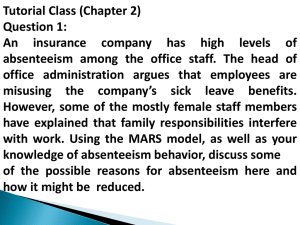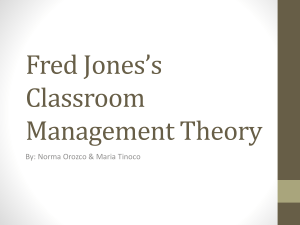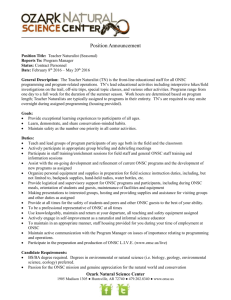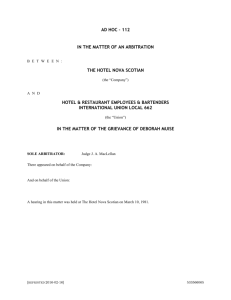Unmotivated Employees
advertisement
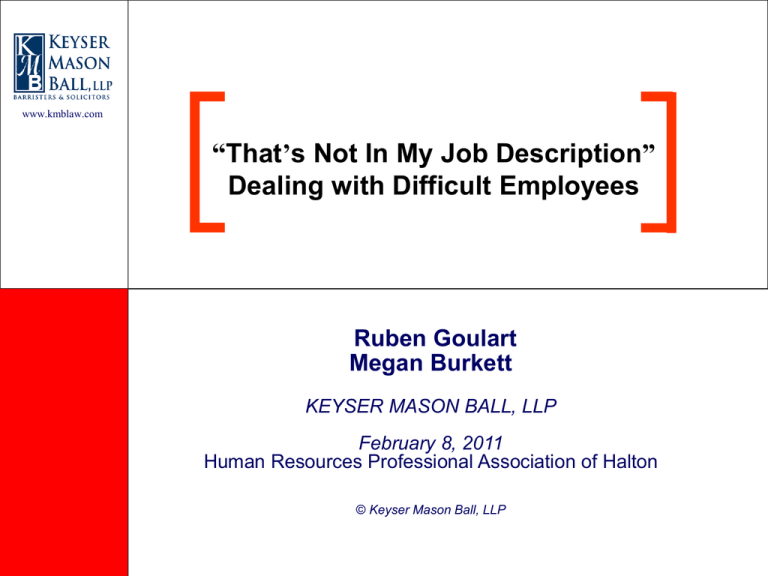
www.kmblaw.com “That’s Not In My Job Description” Dealing with Difficult Employees Ruben Goulart Megan Burkett KEYSER MASON BALL, LLP February 8, 2011 Human Resources Professional Association of Halton © Keyser Mason Ball, LLP Overview www.kmblaw.com . 1) Just Cause 2) Insubordination 3) Unmotivated Employees 4) Innocent Absenteeism 5) Performance Management 6) Discipline Checklist 2 Just Cause www.kmblaw.com . Definition: A breach of the employee’s fundamental obligations to the employer A repudiation of the employment contract Single incident of misconduct generally not enough (unless severe case of theft, assault, or dangerous conduct) Progressive discipline approach depending on nature of breach 3 Insubordination www.kmblaw.com . Definition: An employee’s deliberate disobedience of a direct order Breach of company policies and procedures The order must be reasonable An essential term of employment must be breached 4 Insubordination www.kmblaw.com Bohay v. 567876 Saskatchewan Ltd., 2009 SKPC 128 . Hair stylist Bohay returns from vacation and learns that a co-worker purchased the hair salon and is her new boss No advance notice of impending sale of business provided All employees will lose health benefits Receptionist overheard Bohay on the phone making negative comments about new owner and expressing unhappiness 5 Insubordination www.kmblaw.com Bohay v. 567876 Saskatchewan Ltd., 2009 SKPC 128 con’t . Bohay was called to a meeting Bohay swore during the meeting Discloses that her father and sister are ill When asked directly by Bohay if she is being warned or fired, new boss says “No” and “No” Bohay was terminated before her next shift; she had 22 years of service and was 44 years of age 6 Insubordination www.kmblaw.com . 1. Was there just cause for termination? 2. What steps could the new owner have taken prior to terminating employment? 3. Were there any mitigating factors? 7 Insubordination www.kmblaw.com Bohay v. 567876 Saskatchewan Ltd., 2009 SKPC 128 con’t . Trial outcome: just cause not established Conduct blameworthy, but not sufficient to establish just cause without warning Bohay worked for old boss for 22 years and had an excellent working relationship; with new boss for 4 days Experiencing personal problems – father, sister ill Awarded 9 months 8 Insubordination www.kmblaw.com Chen v. Sable Fish Canada, [2010] B.C.W.L.D. 5850 . Chen was promoted to Production Manager from the role of technician Chen did not possess the people management or organizational skills for role and was transferred to role of Broodstock Manager Sable Fish was having financial trouble; 5 employees were let go and share offering sent out to shareholders 9 Insubordination www.kmblaw.com Chen v. Sable Fish Canada, [2010] B.C.W.L.D. 5850 con’t Chen sent negative and disrespectful letter to 40 people, including shareholders, attacking Sable Fish and management team Accusations of overspending, favouritism, and disastrous management . Chen terminated for cause; had 6 years of service 10 Insubordination www.kmblaw.com . 1. Was there just cause for termination? 2. Were there any mitigating factors? 11 Insubordination www.kmblaw.com Chen v. Sable Fish Canada, [2010] B.C.W.L.D. 5850 con’t . Just cause termination upheld Letter an attempt to embarrass the company No regard to the harm that may be caused to company Fundamental breach of trust Actions irreconcilable with continued employment 12 Unmotivated Employees www.kmblaw.com . Examples include: carelessness lapse in good judgment not completing job duties 13 Unmotivated Employees www.kmblaw.com Leitner v. Wyeth Canada, 2010 ONSC 579 (Canlii) . Leitner held the position of General Product Manager; was 41 years of age with 8 years of service Wyeth conducted an audit of expense accounts Leitner submitted inaccurate information such as incorrect names and dates as well as personal receipts for reimbursement Approximately $500 was improperly claimed 14 Unmotivated Employees www.kmblaw.com Leitner v. Wyeth Canada, 2010 ONSC 579 (Canlii) con’t . Leitner’s explanation was that he reported his expenses irregularly He often had difficulty in remembering the time and place where the expenditures were incurred or had difficulty in locating receipts 15 Unmotivated Employees www.kmblaw.com . 1. Was there just cause for termination? 2. Was his conduct fraudulent or reckless? 3. Are there any mitigating factors? 16 Unmotivated Employees www.kmblaw.com Leitner v. Wyeth Canada, 2010 ONSC 579 (Canlii) con’t . Leitner’s explanation that he was not trying to gain extra compensation but trying to be reimbursed for expenses he incurred His long and distinguished service was a mitigating factor Actions careless or a temporary lapse in good judgment Awarded 10 months of pay in lieu of notice 17 Unmotivated Employees www.kmblaw.com Brock University v. CUPE Local 1295 L.V.I. 3135-7 . Grievor was a cleaner employed on the night shift and had 1 year of seniority with the bargaining unit Previous suspension on record for arriving late to work and for spending time in cleaners room not performing work Grievor was caught laying down on a bench watching television for over 30 minutes when he should have been working Grievor was terminated for just cause 18 Unmotivated Employees www.kmblaw.com . 1. Was there just cause for termination? 2. Are there any mitigating factors? 19 Unmotivated Employees www.kmblaw.com Brock University v. CUPE Local 1295 L.V.I. 3135-7 . Just cause termination upheld Prior discipline and recent incident over a short period of time Grievor spends most of his time unsupervised He could no longer be trusted to perform his work 20 Absenteeism www.kmblaw.com . Definition: Absenteeism: Lateness or missed shifts Innocent absenteeism: for reasons other than illness, injury or for good reason Culpable vs. Non-Culpable Absenteeism Culpable = conduct that is blameworthy Non-Culpable = conduct that is innocent 21 Absenteeism www.kmblaw.com Employees cannot be disciplined for the following: An absence due to illness or injury Non-performance or poor performance due to the illness or injury Circumstances out of the employee’s control What can employees be disciplined for? . Misconduct 22 Absenteeism www.kmblaw.com . Includes misconduct that is related to the absenteeism Employees can be disciplined for the failure to follow an employer’s reporting absences policy including: Call-in procedure Providing required medical documents, or Leaving work early without proper authorization 23 Innocent Absenteeism www.kmblaw.com Jones v. Patriot Forge, 2009 CarswellOnt 306 . Jones was a machine operator who was 44 years of age and had 5 years of service Jones had received a few discipline letters for minor workplace errors or an absence from work over the years Jones missed one week of work and for some of those dates, he had not followed the proper call-in procedure He was suspended for 3 days for not giving proper notice and following absence procedures 24 Innocent Absenteeism www.kmblaw.com Jones v. Patriot Forge, 2009 CarswellOnt 306 con’t . One month later, Jones missed a shift A friend called in the absence and Jones attended at court to be a surety for that friend Jones dismissed for just cause 25 Innocent Absenteeism www.kmblaw.com . 1. Was there just cause for termination? 2. What steps could the company have taken prior to terminating employment? 3. Were there any mitigating factors? 26 Innocent Absenteeism www.kmblaw.com Jones v. Patriot Forge, 2009 CarswellOnt 306 con’t . Judge accepts that Jones was a less than ideal employee No evidence to show that Jones’ absenteeism pattern outside the norm of other employees Jones corrected many of his errors following discipline Just cause termination harsh; 3 months notice awarded 27 Performance Management www.kmblaw.com . Apply a progressive discipline approach Has the employee received verbal and/or written warnings first? Has the employee been warned that the next incident may result in further discipline including termination? Are expectations clearly set out? Is support/training being offered? Is there regular follow-up and communication? 28 Performance Management www.kmblaw.com Jazarevic v. Schaeffler Canada, 2010 ONSC 2491 . Machine operator had 9 years of service and was 43 years of age Schaeffler had 4 step discipline process; any 4 infractions within 12 months will lead to dismissal Jazarevic only had 2 warnings until the year following when his wife died and he was left to raise 5 kids Jazarevic began missing shifts or coming in late on a few occasions, which resulted in 4 warnings over 12 months 29 Performance Management www.kmblaw.com Jazarevic v. Schaeffler Canada, 2010 ONSC 2491 con’t . Jazarevic was warned the next incident would result in termination Incident occurred involving production, including failure to properly set up machine and production of non-confirming parts Jazarevic told company of additional personal issue of his sick mother Schaeffler decided to terminate for cause 30 Performance Management www.kmblaw.com . 1. Was there just cause for termination? 2. What steps could the company have taken prior to terminating employment? 3. Were there any mitigating factors? 31 Performance Management www.kmblaw.com Jazarevic v. Schaeffler Canada, 2010 ONSC 2491 con’t . Judge held that company did not have just cause Discipline Policy should not have mechanical 4 step process Need opportunity for proportionality Many mitigating factors Awarded 7 months notice 32 Discipline Checklist www.kmblaw.com . 1. Know all the facts accurately. Interview witnesses and conduct an investigation (as appropriate). 2. Can the company prove what happened? 3. Is the rule that has been violated reasonable? 4. Did the employee know the rule – or should the employee have known the rule? 33 Discipline Checklist www.kmblaw.com . 4. Is the rule being applied fairly, having regard to the circumstances (includes issue of condonation)? 5. Have the preliminary procedures been followed (i.e. has the employer followed its own rules and procedures)? 6. Review how other employees have been disciplined for same offence. 34 Discipline Checklist www.kmblaw.com . 7. Except in cases such as theft, assault, and other dangerous or harmful offences, has the employee first been warned/counseled? 8. Is this employee personally guilty, rather than being guilty by association with another employee? 9. Does the discipline fit the misconduct? 35 www.kmblaw.com Discipline Checklist 10. What is the employee’s disciplinary record (type, frequency, and age)? 11. How long has the employee been with the organization? 12. Does the employee have a reasonable excuse for the rule infraction or misconduct (i.e. personal circumstances)? . 36 www.kmblaw.com A Final Thought The strategic benefit of a written employment agreement with a termination provision. . 37 www.kmblaw.com Questions? Ruben Goulart Megan Burkett Keyser Mason Ball, LLP (905) 276-9111 www.kmblaw.com . 38

